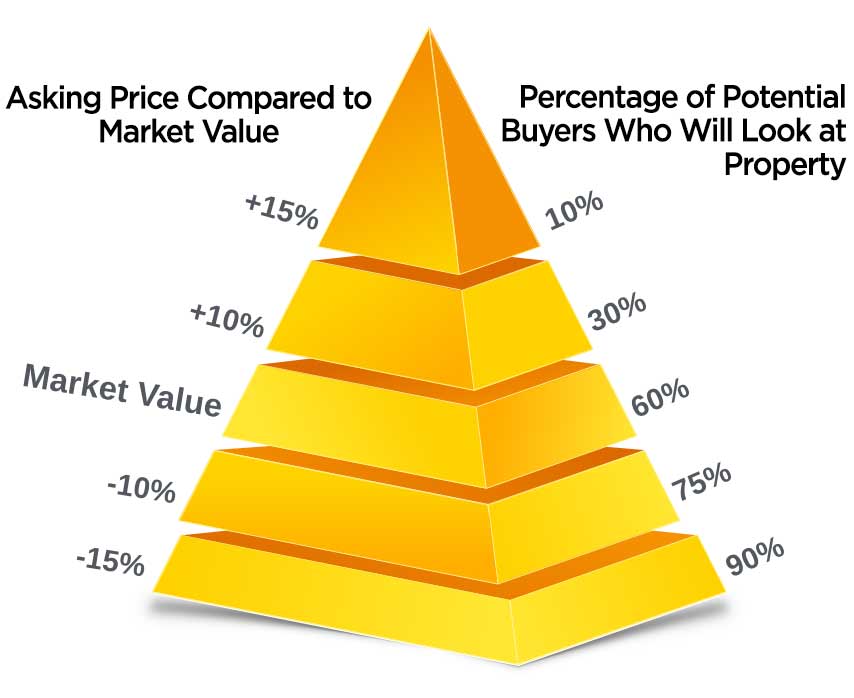
In a hot sellers market like we have right now, where there are many buyers and not enough homes for sale, a popular strategy is underpricing a home and then holding back on offers.
There are many people who ask the question, “Why not just price it at the market value and let it sell?”
The answer is… because it doesn’t work as well that way.
The FOUR ways to price a home
In our experience, there are four ways to price a home in any market:
1. Undervalued
It’s possible you could get multiple offers and sell for more. But there’s also a chance that the right buyer doesn’t show up on offer night. Fear of competition can dissuade interest.
2. Sweet Spot
This is when you price it as close to the estimate of market value, based on information available.
3. No Man’s Land
Priced slightly higher than previous sales. This can be a good strategy in a rising market, where the sales will catch up to the price. But in a level or down market, missing the price by just a little bit means the property likely won’t sell.
4. No Chance Land
We all know about the properties that are so far off the mark that you want to laugh. If pricing can’t be justified by factual market data and logic, then it’s usually not a good idea to price it in this range. But people still do it!
Which option is best?
The answer depends on the market you’re in, and the amount of competition you have.
In a strong sellers market like we have now, the two best strategies out of the four options are #1 and #3.
But really #1 is the better choice.
If you price it in “No Man’s Land”, and most other sellers are underpricing, then the gap between you and the other homes will be significant. Buyers will be drawn to the lower priced properties.
The momentum just isn’t on your side with this option.
On the other hand, when you choose “Undervalued” with an offer date, you get a LOT more interest.
Here’s an example of why:

By lowering the value of the home, it attracts the attention of a lot more buyers. Some of which may see the home and make an offer that has no chance of being successful… but will serve an important role to increase the total number of offers so that the people at the top pay EVEN MORE.
We’ll get into that below.
What do sellers REALLY want?
On the night you take offers, buyers are not in negotiation mode. They are in the mindset that they will have to offer their absolute maximum price, because of the fear that others might make a better offer.
But it’s not ONLY about the price.
Sellers look for FOUR things in their ideal offer:
1. They want the highest price.
2. They want their ideal closing date.
3. They want NO conditions. Conditions on financing or home inspection give the buyer an “out”. They reduce the seller’s certainty of the deal coming together.
4. They want a cheque in hand. Without a cheque, the deal likely falls apart.
Often, if there’s enough offers… the seller will get all four things on their wish list. Interestingly, we’ve seen a cheque in hand with a lower price get the deal, because it’s a guaranteed done deal for the seller.
You likely aren’t getting all four with any other pricing option.
Buyers will know how many offers are submitted, but they will not know the terms (price, closing, inclusions, conditions) of other offers. Which means they really need to squeeze as hard as they can to have a chance.
The whole scenario is set up to put power in the hands of the seller, not the buyer. Some buyers wish for a more open, auction-like process, but that model hasn’t really taken off in North America yet. Auctions are still allowed, provided all parties agree to it, and proper protocols are in place. It’s just not very common practice.
Out of a group of ten competing offers, we’ve noticed certain trends. Usually the bottom 20% are just out of the game completely. 60% of the offers are pretty good and under normal circumstances would be competitive. But it’s the 20% at the top that fight for the prize.
It’s true that underpricing and holding back on offers is a colossal waste of time and resources for nearly everyone involved…
We completely understand. It’s inefficient, and it really gets buyers & agents frustrated.
BUT it’s the most successful way to sell your home for big money… because it’s all a big setup to find that top 20% — those one or two buyers that REALLY, REALLY want it more than anybody else.
That’s why it remains the gold standard in a hot sellers market like this one.